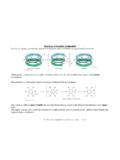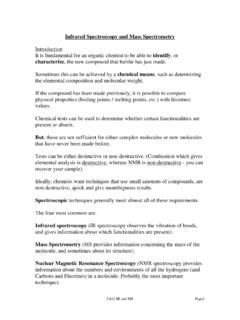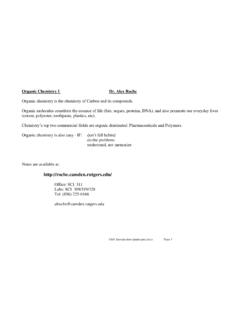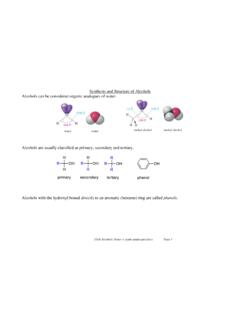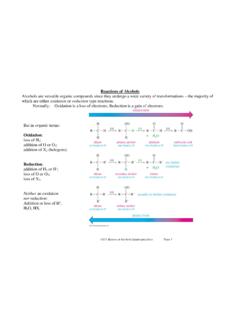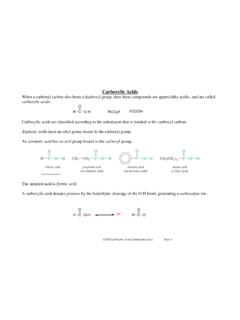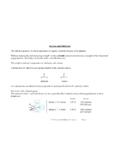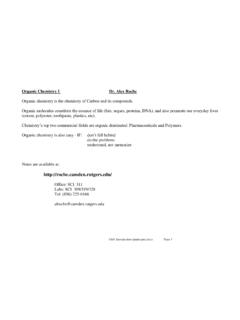Transcription of Introduction to Data Structures and Algorithms
1 Lehrstuhl Informatik 7 (Prof. Reinhard German) Martensstra e 3, 91058 ErlangenIntroduction toData Structures and AlgorithmsChapter:Elementary Data Structures (1)Data Structures and Algorithms (132) overview on simple data Structures for representing dynamic sets of data records Main operations on these data Structures are Insertionand deletionof an element searchingfor an element finding the minimumor maximumelement finding the successoror the predecessorof an element And similar operations .. These data Structures are often implementedusing dynamically allocated objectsand pointersElementary Data StructuresData Structures and Algorithms (133)Typical Examples of Elementary Data Structures Array Stack Queue Linked List TreeElementary Data StructuresData Structures and Algorithms (134)Stack A stackimplements the LIFO (last-in, first-out) policy like a stack of plates, where you can either placean extra plate at the top or remove the topmost plate For a stack, the insert operation is called Push and the delete operation is called PopElementary Data StructuresData Structures and Algorithms (135)Where are Stacks used?
2 A call stackthat is used for the proper executionof a computer program with subroutine or function calls Analysis of context free languages( properly nested brackets) Properly nested: (()(()())), Wrongly nested: (()((()) Reversed Polish notation of terms Compute 2 + 3*5 2 Push 3 Push 5 * +Elementary Data StructuresData Structures and Algorithms (136)Properties of a Stack Stacks can be defined by axioms based on the stack operations , a certain data structure is a stack if the respective axioms hold For illustration some examples for such axioms - the typical axioms are(where S is a Stack which can hold elements x of some setX) If not full(S): Pop(S) o (Push(S,x)) = xfor all x X If not empty(S): Push(S, Pop(S)) = SElementary Data StructuresData Structures and Algorithms (137)Typical Implementation of a Stack A typical implementation of a stack of size nis based on an arrayS[ ] so it can hold at most n elements top(S) is the index of the most recentlyinserted element The stack consists of elementsS[1.))]
3 Top(S)], where S[1] is the element at the bottom of the stack, and S[top(S)] is the element at the top. The unused elements S[top(S)+1 .. n]are not in the stackElementary Data StructuresSTopPushPop4321 Data Structures and Algorithms (138)Stack If top(S) = 0 the stack is empty no element can be popped If top(S) = n the stack is full no further element can be pushedElementary Data StructuresData Structures and Algorithms (139)Elementary Data StructuresExample (Stack Manipulation)Start with stack given,denote changes of stack state Push(S, 17) Pop(S), Pop(S), Pop(S), Push(S, 5) Pop(S), Pop(S) Pop(S)S12345673323top(S)Data Structures and Algorithms (140)Elementary Data StructuresS:S:S:S:7654321765432176543217 654321 Top[S]=3 Top=4 Top=2 Top=0333323235317push(S,17)pop (S) 17pop (S) 3pop (S) 23push(S,5)pop (S) 5pop (S) 3pop (S)Error:underflowData Structures and Algorithms (141)Pseudo Code for Stack operations Number of elementsElementary Data StructuresNumElements (S)return top[S]Data Structures and Algorithms (142)Pseudo Code for Stack operations Test for emptiness Test for stack full Elementary Data StructuresStack_Empty(S)if top[S]=0then return trueelse return false Stack_Full (S)if top[S]=nthen return trueelse return false Data Structures and Algorithms (143)Pseudo Code for Stack operations Pushing and PoppingElementary Data StructuresPush(S,x)if Stack_Full(S)then error "overflow"else top[S] := top[S]+1S[top[S]] := xPop(S)if Stack_Empty(S)then error "underflow"else top[S] := top[S]-1return S[top[S]+1]This pseudo code containserror handling functionalityData Structures and Algorithms (144)Pseudo Code for Stack operations (Asymptotic) Runtime NumElements:number of operations independent of size n of stack constant O(1) Stack_Emptyand Stack_Full.
4 Number of operations independent of size n of stack constant O(1) Pushand Pop:number of operations independent of size n of stack constant O(1)Elementary Data StructuresData Structures and Algorithms (145)Queue A queueimplements the FIFO (first-in, first-out) policy Like a line of people at the post office or in a shop For a queue, the insert operation is called Enqueue(=> place at the tail of the queue) and the delete operation is called Dequeue(=> take from the head of the queue)Elementary Data StructurestailheaddequeueenqueueData Structures and Algorithms (146)Where are Queues used? In multi-tasking systems (communication, synchronization) In communication systems (store-and-forward networks) In servicing systems (queue in front of the servicing unit) Queuing networks (performance evaluation of computer andcommunication networks)Elementary Data StructuresData Structures and Algorithms (147)Typical Implementation of a Queue A typical implementation of a queue consisting of at most n-1elements is based on an arrayQ[1.]
5 N] Its attribute head(Q)points to the head of the queue. Its attribute tail(Q)points to the positionwhere a new element will be inserted into the queue( one position behind the last element of the queue). The elements in the queue are in positionshead(Q), head(Q)+1, .., tail(Q)-1, where we wrap around the arrayboundary in the sense that Q[1] immediately follows Q[n]Elementary Data StructuresData Structures and Algorithms (148)Elementary Data StructuresQ12345678910head(Q)tail(Q)Exam ple (1) Insert a new element (4.) (n = length (Q) = 10)Q12345678910head(Q)tail(Q) Structures and Algorithms (149)Elementary Data StructuresQ12345678910head(Q)tail(Q)Exam ple (2) Insert one more element (5.) And again: Insert one more element (6.) (Q)tail(Q) (Q)tail(Q) Structures and Algorithms (150)Elementary Data StructuresTypical Implementation of a Queue Number of elements in queue If tail > head:NumElements(Q) = tail - head If tail < head:NumElements(Q) = tail head + n If tail = head:NumElements(Q) = 0 Initially:head[Q] = tail[Q] = 1 Position of elements in queue The x.
6 Element of a queue Q (1 x NumElements(Q)is mapped to array positionhead(Q) + (x - 1) if x n head +1 (no wrap around)head(Q) + (x - 1) - n if x > n head +1 (wrap around)Data Structures and Algorithms (151)Elementary Data StructuresTypical Implementation of a Queue Remark: A queue implemented by a n-element arraycan hold at most n-1 elements otherwise we could not distinguishbetween an empty and a full queue A queue Q is empty: ( NumElements(Q) = 0) if head(Q) = tail(Q) A queue Q is full: ( NumElements(Q) = n-1) if head(Q) = (tail(Q) + 1)(head(Q) > tail(Q)) if head(Q) = (tail(Q) - n + 1)(head(Q) < tail(Q))Data Structures and Algorithms (152)Elementary Data StructuresQ12345678910head(Q)tail(Q)Exam ple (Queue Manipulation)Start with queue given, denote changes of queue state Enqueue(Q, 2), Enqueue(Q, 3), Enqueue(Q, 7) Dequeue(Q)4124 Data Structures and Algorithms (153)Queue operations Enqueue and DequeueElementary Data StructuresEnqueue(Q,x)Q[tail[Q]] := xif tail[Q]=length[Q]then tail[Q] := 1else tail[Q] := tail[Q]+1 Dequeue(Q)x := Q[head[Q]]if head[Q]=length[Q]then head[Q] := 1else head[Q] := head[Q]+1return xPrecondition: queue not fullPrecondition: queue not emptyThis pseudo code does not containerror handling functionality(see stack push and pop)Data Structures and Algorithms (154)Pseudo Code for Queue operations (Asymptotic) Runtime Enqueueand Dequeue.)
7 Number of operations independent of size n of queue constant O(1)Elementary Data StructuresLehrstuhl Informatik 7 (Prof. Reinhard German) Martensstra e 3, 91058 ErlangenIntroduction toData Structures and AlgorithmsChapter:Elementary Data Structures (2)Data Structures and Algorithms (156)Typical Examples of Elementary Data Structures Array Stack Queue Linked List TreeElementary Data StructuresData Structures and Algorithms (157)Linked List In a linked list, the elements are arranged in a linear order, each element (except the first one) has a predecessorandeach element (except the last one) has a successor. Unlike an array, elements are not addressed by an index,but by a pointer(a reference). There are singlylinked lists and doublylinked lists. A list may be sorted or unsorted. A list may be circular ( a ring of elements). Here we consider mainly unsorted, doubly linked listsElementary Data StructuresData Structures and Algorithms (158)Linked List Each element x of a (doubly) linked list has three fields A pointer prevto the previous element A pointer next to the next element A field that contains a key(value of a certain type) Possibly a field that contains satellite data (ignored in the following) Pointer fields that contain no pointer pointing to another elementcontain the special pointer NIL( ) The pointer head[L] points to the first element of the linked list If head[L] = NIL the list L is an empty listElementary Data StructuresprevkeynextOne element x :(consist of 3 fields)Data Structures and Algorithms (159)Linked List In a linked list, the insert operation is called List_Insert,and the delete operation is called List_Delete.
8 In a linked list we may search for an element with a certain key kby calling Data StructuresLinked List Example: dynamic set {11, 2 ,7 , 13}head[L]117132prevkeynextNotice:prev[h ead] = NIL and next[tail] = NILData Structures and Algorithms (160)Some Examples for the Use of Linked Lists Lists of passengers of a plane or a hotel Card games (sorting cards corresponding to a certain order, insertingnew cards into or removing cards out of the sequence) To-do lists (containing entries for actions to be done) Hash Lists ( Hashing, dealt later in this lecture)Elementary Data StructuresData Structures and Algorithms (161)Searching a Linked List The procedure List_search (L, k) finds the first elementwith key k in list L and returns a pointer to that element. If no element with key k is found, the special pointer NIL isreturned. It takes at most (n)time to search a list of n objects(linear search)Elementary Data StructuresList_Search(L,k)x := head[L]while x!=NIL and key[x]!=k dox := next[x]return xData Structures and Algorithms (162)Inserting into a Linked List The procedure List_insert(L,x) inserts a new element xas the new head of list L The runtime for List_Insert on a list of length n is constant (O(1))Elementary Data Structureshead[L]List_Insert(L,x)next[x] := head[L]if head[L]!
9 =NIL thenprev[head[L]] := xhead[L] := xprev[x] := NILxkey(x)Data Structures and Algorithms (163)Deleting from a Linked List The procedure List_Delete (L, x) removes an element x from thelinked list L, where the element is given by a pointer to x. If you want to delete an element given by its key k, you have tocompute a pointer to this element ( by using List_search(L, k))Elementary Data StructuresList_Delete(L,x)if prev[x]!=NILthen next[prev[x]] := next[x]else head[L] := next[x]if next[x]!=NILthen prev[next[x]] := prev[x] x not the first element x not the last elementData Structures and Algorithms (164)Deleting from a Linked List Elementary Data StructuresList_Delete(L,x)if prev[x]!=NILthen next[prev[x]] := next[x]else head[L] := next[x]if next[x]!=NILthen prev[next[x]] := prev[x]head[L]head[L]a)b)a)b) x xData Structures and Algorithms (165)Deleting from a Linked List The runtime for List_Delete on a list of length n is constant (O(1)) If you want to delete an element with a certain key, you must firstfind that element by executing List_Search, which takes (n) timein the worst caseElementary Data StructuresData Structures and Algorithms (166)Elementary Data Structures117132head[L]List_insert (L,x)with key[x] = 251125713head[L]11head[L]2 List_Delete (L,x)where x points to element with key[x] = 225713 Inserting and deleting :Data Structures and Algorithms (167)Tree Any data structure consisting of elements of the same typecan be represented with the help of pointers(in a similar way as we implemented lists).
10 Very important examples of such data Structures are trees. Trees are graphs that contain no cycle:every non-trivial path through a tree starting at a node and ending inthe same node, does traverse at least one edge at least twice. There exist many kinds of trees. Examples are: Binary trees Trees with unbounded branching Binary search trees Red-black treesElementary Data StructuresData Structures and Algorithms (168)Some Examples for the Use of Trees Systematically exploring various ways of proceeding( in chess or planning games) Morse trees (coding trees) Heaps ( heap sort) Search treesElementary Data StructuresData Structures and Algorithms (169)Tree A binary treeconsists of nodes with the following fields A keyfield Possibly some satellite data (ignored in the following) Three pointers p, leftand rightpointing to the parent node, left childnode and right child node Be x an element (or node) of a tree If p[x] = NIL x represents the root node If both left[x] = NIL and right[x] = NIL x represents a leaf node For each tree T there is a pointer root[T] that points to the root of T If root[T] = NIL, the tree T is emptyElementary Data StructuresData Structures and Algorithms (170)Binary Tree (Example)Elementary Data Structuresprightleftkey(+ )
